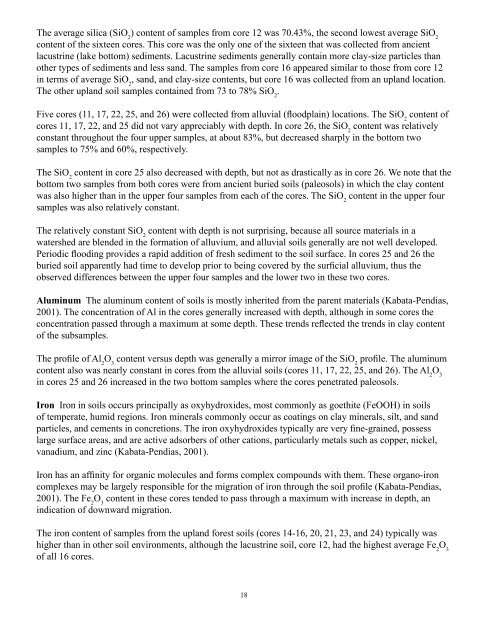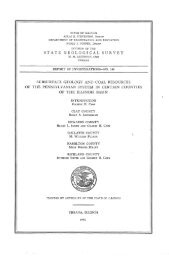The average silica (SiO 2) content <strong>of</strong> samples from core 12 was 70.43%, the second lowest average SiO 2content <strong>of</strong> the sixteen cores. This core was the only one <strong>of</strong> the sixteen th<strong>at</strong> was collected from ancientlacustrine (lake bottom) sediments. Lacustrine sediments generally contain more clay-size particles thanother types <strong>of</strong> sediments and less sand. The samples from core 16 appeared similar to those from core 12in terms <strong>of</strong> average SiO 2, sand, and clay-size contents, but core 16 was collected from an upland loc<strong>at</strong>ion.The other upland soil samples contained from 73 to 78% SiO 2.Five cores (<strong>11</strong>, 17, 22, 25, and <strong>26</strong>) were collected from alluvial (floodplain) loc<strong>at</strong>ions. The SiO 2content <strong>of</strong>cores <strong>11</strong>, 17, 22, and 25 did not vary appreciably with depth. In core <strong>26</strong>, the SiO 2content was rel<strong>at</strong>ivelyconstant <strong>through</strong>out the four upper samples, <strong>at</strong> about 83%, but decreased sharply in the bottom twosamples to 75% and 60%, respectively.The SiO 2content in core 25 also decreased with depth, but not as drastically as in core <strong>26</strong>. We note th<strong>at</strong> thebottom two samples from both cores were from ancient buried soils (paleosols) in which the clay contentwas also higher than in the upper four samples from each <strong>of</strong> the cores. The SiO 2content in the upper foursamples was also rel<strong>at</strong>ively constant.The rel<strong>at</strong>ively constant SiO 2content with depth is not surprising, because all source m<strong>at</strong>erials in aw<strong>at</strong>ershed are blended in the form<strong>at</strong>ion <strong>of</strong> alluvium, and alluvial soils generally are not well developed.Periodic flooding provides a rapid addition <strong>of</strong> fresh sediment to the soil surface. In cores 25 and <strong>26</strong> theburied soil apparently had time to develop prior to being covered <strong>by</strong> the surficial alluvium, thus theobserved differences between the upper four samples and the lower two in these two cores.Aluminum The aluminum content <strong>of</strong> soils is mostly inherited from the parent m<strong>at</strong>erials (Kab<strong>at</strong>a-Pendias,2001). The concentr<strong>at</strong>ion <strong>of</strong> Al in the cores generally increased with depth, although in some cores theconcentr<strong>at</strong>ion passed <strong>through</strong> a maximum <strong>at</strong> some depth. These trends reflected the trends in clay content<strong>of</strong> the subsamples.The pr<strong>of</strong>ile <strong>of</strong> Al 2O 3content versus depth was generally a mirror image <strong>of</strong> the SiO 2pr<strong>of</strong>ile. The aluminumcontent also was nearly constant in cores from the alluvial soils (cores <strong>11</strong>, 17, 22, 25, and <strong>26</strong>). The Al 2O 3in cores 25 and <strong>26</strong> increased in the two bottom samples where the cores penetr<strong>at</strong>ed paleosols.Iron Iron in soils occurs principally as oxyhydroxides, most commonly as goethite (FeOOH) in soils<strong>of</strong> temper<strong>at</strong>e, humid regions. Iron minerals commonly occur as co<strong>at</strong>ings on clay minerals, silt, and sandparticles, and cements in concretions. The iron oxyhydroxides typically are very fine-grained, possesslarge surface areas, and are active adsorbers <strong>of</strong> other c<strong>at</strong>ions, particularly metals such as copper, nickel,vanadium, and zinc (Kab<strong>at</strong>a-Pendias, 2001).Iron has an affinity for organic molecules and forms complex compounds with them. These organo-ironcomplexes may be largely responsible for the migr<strong>at</strong>ion <strong>of</strong> iron <strong>through</strong> the soil pr<strong>of</strong>ile (Kab<strong>at</strong>a-Pendias,2001). The Fe 2O 3content in these cores tended to pass <strong>through</strong> a maximum with increase in depth, anindic<strong>at</strong>ion <strong>of</strong> downward migr<strong>at</strong>ion.The iron content <strong>of</strong> samples from the upland forest soils (cores 14-16, 20, 21, 23, and 24) typically washigher than in other soil environments, although the lacustrine soil, core 12, had the highest average Fe 2O 3<strong>of</strong> all 16 cores.18
Potassium Typically, potassium occurs in <strong>Illinois</strong> soils in the primary minerals, particularly feldsparsand micas (Sparks, 1995), and the clay mineral illite, but it can also be held as an exchangeable ion on thesoil exchange complex. Because feldspars and micas are quite resistant to we<strong>at</strong>hering, K is not commonlyfound <strong>at</strong> high concentr<strong>at</strong>ions in the soil solution. In fact, Severson and Shacklette (1988) estim<strong>at</strong>ed th<strong>at</strong> 90to 98 percent <strong>of</strong> the K in soils is unavailable to plants.Calcium Calcite (CaCO 3) and dolomite [CaMg(CO 3) 2] are common sources <strong>of</strong> calcium in soils, however,not all soils contain calcite or dolomite. Calcium can also be held as an exchangeable ion on the soilexchange complex. The content <strong>of</strong> CaO in most <strong>of</strong> the cores was highest in the surface sample andquickly decreased to nearly constant values in samples from gre<strong>at</strong>er depths. In some cores the CaOcontent increased in deeper samples because the calcareous till underlying the soil was penetr<strong>at</strong>ed. This isespecially evident from the pr<strong>of</strong>iles for CaO in cores 12 and 16.Calcium may be present in soils because <strong>of</strong> human activities such as the use <strong>of</strong> limestone or dolomite inroad building or for agricultural liming to reduce soil acidity. The l<strong>at</strong>ter activity might explain the highCaO content (8.73%) in the surface sample <strong>of</strong> core 19.Magnesium Sedimentary minerals such as dolomite are probably the principal sources <strong>of</strong> magnesiumin <strong>Illinois</strong> soils. The d<strong>at</strong>a for the 16 cores generally showed increasing MgO content with depth, and adecrease in MgO in the deepest samples analyzed. As with CaO, the MgO content <strong>of</strong> the deepest samplesfrom cores 12 and 16 was higher than in samples from shallower in the pr<strong>of</strong>ile, because <strong>of</strong> penetr<strong>at</strong>ion <strong>of</strong>the underlying till. Core 19 had elev<strong>at</strong>ed MgO content in the uppermost sample, also possibly a result <strong>of</strong>agricultural liming. Once released from its source mineral, Mg compounds are somewh<strong>at</strong> soluble in w<strong>at</strong>erand Mg leached from high in the soil pr<strong>of</strong>ile to deeper positions. This is evidenced <strong>by</strong> maxima in the MgOcontent <strong>at</strong> depths <strong>of</strong> 1.5 to 4 feet, as Mg is adsorbed <strong>by</strong> the soil exchange complex. <strong>Cores</strong> 22, 25, and <strong>26</strong>are exceptions.Sodium Sodium-rich feldspar is probably the principal source <strong>of</strong> sodium in soils (Sparks, 1995). Sodiumminerals generally are easily we<strong>at</strong>hered, and once released from the parent mineral, sodium is quitemobile. Sodium forms many w<strong>at</strong>er-soluble compounds in soils, and is, therefore, easily leached from thesoil column. The trends for the concentr<strong>at</strong>ion <strong>of</strong> Na 2O in the sixteen cores were not consistent betweencores. In some cores the concentr<strong>at</strong>ion <strong>of</strong> Na 2O decreased with depth (core <strong>26</strong>), in others it increased (core13), and in others it passed <strong>through</strong> a maximum (core 12) or a minimum (core <strong>11</strong>). In other cores (15, 21,22, and 24) the Na 2O content varied irregularly with depth. A small portion <strong>of</strong> the Na present in the parentm<strong>at</strong>erials likely was incorpor<strong>at</strong>ed onto exchangeable positions on clay minerals, such as smectites, butmost Na probably leached from the soil to the groundw<strong>at</strong>er system.Titanium The sources <strong>of</strong> titanium in soils are oxides, such as rutile (TiO 2), and ilmenite (FeTiO 3)(Kab<strong>at</strong>a-Pendias, 2001), neither <strong>of</strong> which is easily we<strong>at</strong>hered. These minerals occur nearly undecomposedin soils. Titanium presents no environmental concerns in soils (Kab<strong>at</strong>a-Pendias, 2001). In almost everycore the TiO 2content increased to depths <strong>of</strong> one to two feet then decreased. Only in cores 22, 25, and<strong>26</strong> was there no increase in the TiO 2content just below the surface, but a steady increase in content withdepth was observed.Phosphorus The content <strong>of</strong> phosphorus in soils is low, which makes the identific<strong>at</strong>ion <strong>of</strong> phosphorusbearingminerals difficult. Ap<strong>at</strong>ite [Ca 5(F,Cl,OH)(PO 4) 3] has been identified in the silt-size fraction <strong>of</strong>some soils and might be the principal source <strong>of</strong> phosphorous, but most inorganic phosph<strong>at</strong>e in soils occurs19
- Page 1 and 2: A Progress Report on the Descriptio
- Page 3 and 4: INTRODUCTIONThe Illinois State Geol
- Page 5 and 6: As continental glaciers advanced in
- Page 7 and 8: In areas where the glacial sediment
- Page 9 and 10: the boundary between them. Where su
- Page 11 and 12: Occlusion refers to the physical en
- Page 13 and 14: tungsten carbide grinding capsule t
- Page 15 and 16: RESULTS AND DISCUSSIONSampling Plan
- Page 17 and 18: increases also. If the correlation
- Page 19: CO 2 gas= CO 2 aqCO 2 aq+ H 2O = H
- Page 23 and 24: on oxides and hydroxides. Fertilize
- Page 25 and 26: For most cores, the Rb content was
- Page 27 and 28: Brady, N. C. and R. R. Weil, 1999,
- Page 29 and 30: Killey, M. M., 1998, Illinois’ Ic
- Page 31 and 32: Table 1. Core number, county name,
- Page 33 and 34: Table 3. Texture of samples from co
- Page 35 and 36: Table 9. Texture of samples from co
- Page 37 and 38: Table 15. Texture of samples from c
- Page 39 and 40: Table 19. Soil texture, soil type,
- Page 41 and 42: Table 20 continued. Correlation coe
- Page 43 and 44: Table 21. Elemental composition of
- Page 45 and 46: Table 23. Elemental composition of
- Page 47 and 48: Table 25. Elemental composition of
- Page 49 and 50: Table 27. Elemental composition of
- Page 51 and 52: Table 29. Elemental composition of
- Page 53 and 54: Table 31. Elemental composition of
- Page 55 and 56: Table 33. Elemental composition of
- Page 57 and 58: Table 35. Elemental composition of
- Page 59 and 60: Table 37. Means and ranges of eleme
- Page 61 and 62: Sample locationFigure 2 Sample loca
- Page 63 and 64: Figure 461
- Page 65 and 66: Figure 6.63
- Page 67 and 68: Figure 8.65
- Page 69 and 70: Figure 10.67
- Page 71 and 72:
Figure 12.69
- Page 73 and 74:
Figure 14.71
- Page 75 and 76:
Figure 16.73
- Page 77 and 78:
Figure 18.75
- Page 79 and 80:
Figure 20.77
- Page 81 and 82:
Figure 22.79
- Page 83 and 84:
Figure 24.81
- Page 85 and 86:
Figure 26.83
- Page 87 and 88:
Figure 28.85
- Page 89 and 90:
Figure 31.87
- Page 91 and 92:
Figure 33.89
- Page 93 and 94:
Figure 35.91
- Page 95:
Figure 37.93
















